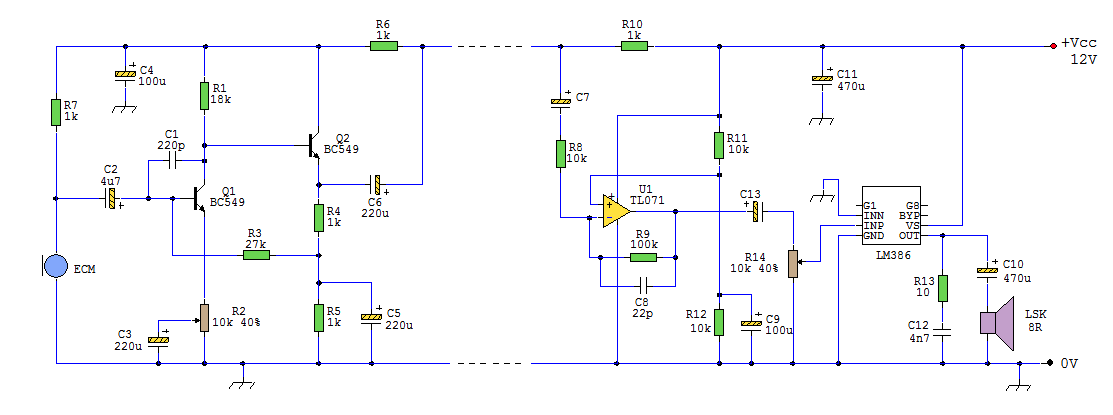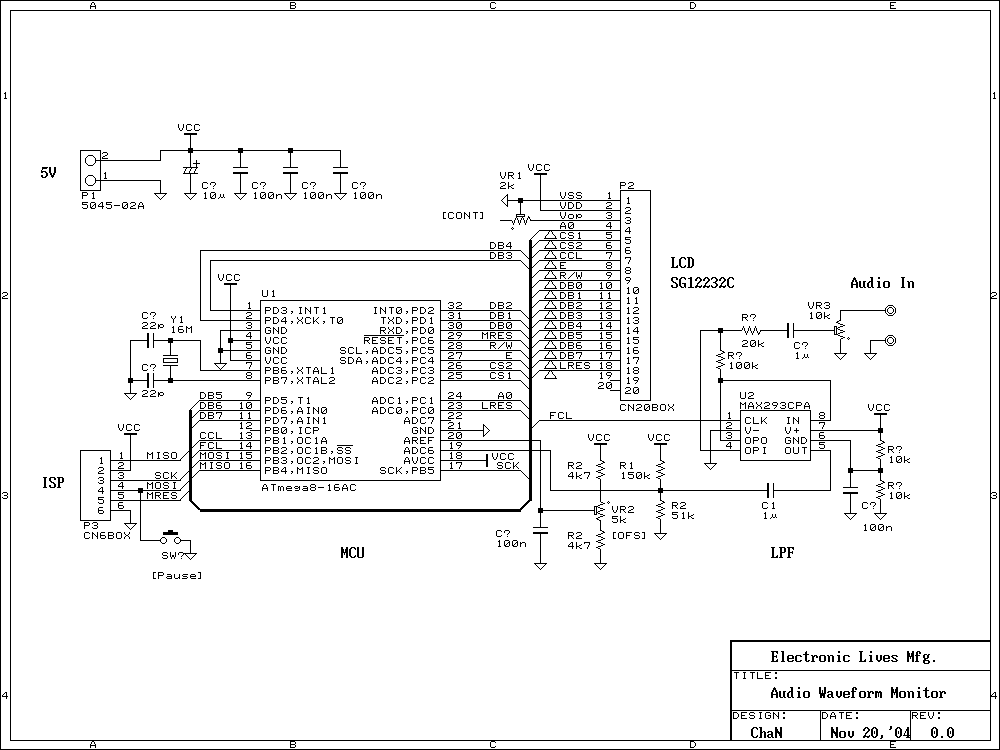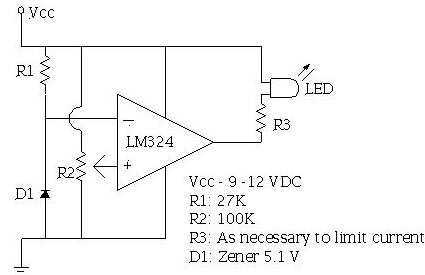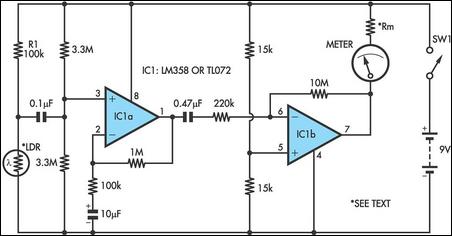
Security Monitor

This circuit can be utilized in a garden setting to detect unusual sounds or wildlife noises. It can also monitor sounds around a car parked in a remote location. The cable used for the setup can either be visible or concealed; a screened cable is not necessary, and alternatives such as bell wire or speaker cable may be employed. Starting from the right-hand side, the circuit includes a power supply. A standard 12V power supply or a 12V car battery can be used. The circuit is divided into two sections: a remote microphone preamplifier and an audio amplifier based on the National Semiconductor LM386 audio amplifier. The remote preamplifier utilizes an ECM microphone to capture sound. It features a direct-coupled two-stage amplifier constructed around transistors Q1 and Q2, which amplify the weak signal from the microphone. A preset resistor (R2) serves as a gain control, while capacitor C1 provides high-frequency roll-off to the audio response. Q1 operates at a low collector current to achieve a high signal-to-noise ratio, and Q2’s collector is biased to approximately half the supply voltage to maximize dynamic range. The power supply for the preamplifier is connected via resistors R10 and R6 from the 12V supply. Capacitor C4 decouples the preamplifier power supply, preventing AC voltages on the power lines. The amplified audio output from Q2's collector is fed onto the supply lines through a 220µF capacitor (C6). The low output impedance of Q2 necessitates the relatively high value of C6, which also serves to block DC voltage from the power supply while allowing audio signals to pass. At the opposite end of the circuit, capacitor C7 (10µF) transmits the amplified audio to the listening location. The signal undergoes further amplification with a x10 voltage gain using the TL071 operational amplifier. Capacitor C8 (22pF) rolls off high-frequency responses above 100kHz to mitigate radio interference that may be picked up by long wires. After amplification by the op-amp, the audio is sent to the LM386 audio amplifier. Resistor R14 functions as a volume control, while resistors R13 and capacitor C12 help prevent potential instability in the LM386, as recommended by the manufacturer. The audio output is approximately 1 watt into an 8-ohm loudspeaker, with a distortion rate of about 0.2%. Headphones can be used as an alternative output, although it is advisable to include a series resistor matching the impedance of the headphones.
The circuit design effectively combines a remote microphone preamp and an audio amplifier to facilitate sound monitoring in various environments. The use of an ECM microphone ensures high sensitivity to sound, while the two-stage transistor amplifier enhances the weak microphone signal, optimizing it for further processing. The gain control provided by the preset resistor allows for adjustments based on the environment, accommodating varying sound levels. The capacitors employed throughout the circuit play critical roles in both signal integrity and power supply decoupling, thus ensuring a clean audio output devoid of unwanted noise.
The TL071 operational amplifier is chosen for its low noise and high performance, making it suitable for audio applications. The design considerations for high-frequency roll-off are particularly important in environments where radio frequency interference could degrade audio quality. The LM386 audio amplifier is a robust choice for driving speakers or headphones, with its built-in features allowing for efficient amplification with minimal distortion. The overall circuit is well-suited for applications requiring discreet sound monitoring, providing reliable performance in remote locations.Use this in your garden and listen for any unusual sounds, or maybe just wildlife noises. If you have a car parked in a remote location, the microphone will also pick up any sounds od activity in this area. The cable may be visible or hidden, screened cable is not necessary and you can use bellwire or speaker cable if desired.
Starting from the right hand side, the power supply. I have used 12V as a standard power supply voltage, or a 12V car battery may be used. The circuit is in two halves, a remote microphone preamp, and an audio amplifier based around the National Semiconductor LM386 audio amplifier. The remote preamp uses an ECM microphone to monitor sound. A direct coupled 2 stage amplifier built around Q1 and Q2 amplify the weak microphone signal. Preset resistor R2 acts as a gain control, and C1 provides some high frequency roll off to the overall audio response.
Q1 is run at a low collector current for a high signal to noise ratio, whilst Q2 collector is biased to around half the supply voltage for maximum dynamic range. The power supply for this preamp is fed via R10 and R6 from the 12V supply. C4 ensures that the preamp power supply is decoupled and no ac voltages are present on the power lines.
The amplified audio output from Q2 collector is fed onto the supply lines via C6 a 220u capacitor. The output impedance of Q2 is low, hence the relatively high value of C6. C6 also has a second purpose of letting the output audio signals pass, whilst blocking the dc voltage of the power supply. At the opposite end, C7 a 10u capacitor, brings home the amplified audio to the listening location. The signal is first further amplifier by a x10 voltage gain amplified using the TL071. C8, a 22p capacitor again rolls off some high frequency response above 100kHz. This is necessary as long wires may pick up a little radio interference. After amplification by the op-amp, the audio is finally passed to the LM386 audio amplifier. R14 acts as volume control. R13 and C12 prevent possible instability in the LM386 and are recommended by the manufacturer. Audio output is around 1 watt into an 8 ohm loudspeaker, distortion about 0. 2%. If preferred headphones could be used, although I`d recommend a series resistor of the same value impedance as the headphones.
🔗 External reference
The circuit design effectively combines a remote microphone preamp and an audio amplifier to facilitate sound monitoring in various environments. The use of an ECM microphone ensures high sensitivity to sound, while the two-stage transistor amplifier enhances the weak microphone signal, optimizing it for further processing. The gain control provided by the preset resistor allows for adjustments based on the environment, accommodating varying sound levels. The capacitors employed throughout the circuit play critical roles in both signal integrity and power supply decoupling, thus ensuring a clean audio output devoid of unwanted noise.
The TL071 operational amplifier is chosen for its low noise and high performance, making it suitable for audio applications. The design considerations for high-frequency roll-off are particularly important in environments where radio frequency interference could degrade audio quality. The LM386 audio amplifier is a robust choice for driving speakers or headphones, with its built-in features allowing for efficient amplification with minimal distortion. The overall circuit is well-suited for applications requiring discreet sound monitoring, providing reliable performance in remote locations.Use this in your garden and listen for any unusual sounds, or maybe just wildlife noises. If you have a car parked in a remote location, the microphone will also pick up any sounds od activity in this area. The cable may be visible or hidden, screened cable is not necessary and you can use bellwire or speaker cable if desired.
Starting from the right hand side, the power supply. I have used 12V as a standard power supply voltage, or a 12V car battery may be used. The circuit is in two halves, a remote microphone preamp, and an audio amplifier based around the National Semiconductor LM386 audio amplifier. The remote preamp uses an ECM microphone to monitor sound. A direct coupled 2 stage amplifier built around Q1 and Q2 amplify the weak microphone signal. Preset resistor R2 acts as a gain control, and C1 provides some high frequency roll off to the overall audio response.
Q1 is run at a low collector current for a high signal to noise ratio, whilst Q2 collector is biased to around half the supply voltage for maximum dynamic range. The power supply for this preamp is fed via R10 and R6 from the 12V supply. C4 ensures that the preamp power supply is decoupled and no ac voltages are present on the power lines.
The amplified audio output from Q2 collector is fed onto the supply lines via C6 a 220u capacitor. The output impedance of Q2 is low, hence the relatively high value of C6. C6 also has a second purpose of letting the output audio signals pass, whilst blocking the dc voltage of the power supply. At the opposite end, C7 a 10u capacitor, brings home the amplified audio to the listening location. The signal is first further amplifier by a x10 voltage gain amplified using the TL071. C8, a 22p capacitor again rolls off some high frequency response above 100kHz. This is necessary as long wires may pick up a little radio interference. After amplification by the op-amp, the audio is finally passed to the LM386 audio amplifier. R14 acts as volume control. R13 and C12 prevent possible instability in the LM386 and are recommended by the manufacturer. Audio output is around 1 watt into an 8 ohm loudspeaker, distortion about 0. 2%. If preferred headphones could be used, although I`d recommend a series resistor of the same value impedance as the headphones.
🔗 External reference





